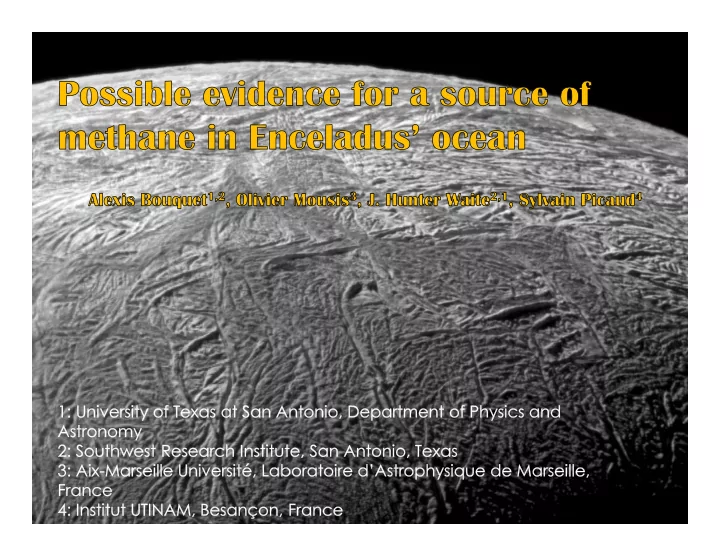

VOLATILES IN THE PLUMES OF ENCELADUS • Ocean under ~ 35 km of ice • Water vapor plumes from the ocean • Not only water! Also: Carbon dioxide Methane Nitrogen/carbon monoxide? Ammonia And others… Credit: NASA/JPL/Caltech
VOLATILES IN THE PLUMES OF ENCELADUS How do we know? The Ion and Neutral Mass Spectrometer (INMS) on Cassini
VOLATILES IN THE PLUMES OF ENCELADUS • Volatiles: the conditions of formation of Enceladus Artist vision of the solar nebula. Credit: NASA How is the mixture we’re seeing today representative of the original one?
WHAT CAN CHANGE THE MIXTURE OF VOLATILES? Trapping in clathrate hydrates • Clathrates: guest molecules trapped in water cages • Several types depending on the guests Credit: Caltech • Formation: Abundance of water, low temperature, high pressure
CLATHRATES Potentially ubiquitous in the solar system Formation in liquid water or in solid ice Images credit : NASA
CLATHRATES Present on Earth • Methane clathrates in sediments in the oceans • “Clathrate gun” hypothesis Credit: NASA
SUBGLACIAL LAKE MODEL OF CLATHRATE FORMATION • Thermodynamic statistical model describing the guest- clathrate interaction • Applied to Vostok lake • Volatiles supplied by melting of ice at the liquid/ice interface Credit: Nicolle Rager-Fuller / NSF
WHAT SPECIES CAN BE TRAPPED? • In Enceladus’ plumes: Carbon dioxide, Nitrogen, Methane, Carbon Monoxide, Hydrogen Sulfide • Noble gases: Argon, Krypton, Xenon: tracers of evolution
ARE THE CONDITIONS MET? • Below room temperature (300K) formation and stability is possible
WHAT HAPPENS WHEN WE RUN THE MODEL? Dotted or solid lines for different clathrate structures • Depletion of methane in all scenarios
FATE OF THE CLATHRATES • Calculated density lower than salt water • Clathrates are not even full! Credit: SwRI
POSSIBLE EXPLANATIONS • Clathrates are dragged along and ejected in major quantities • Hydrothermal activity: Rock/water reactions Ulterior processes involving hydrogen produced by the vents Do we see hydrogen?
HYDROGEN, THE “SMOKING GUN” • Do we see hydrogen? Yes, we do! • Not subject to trapping in clathrates • But… Ice grains impacts Titanium reacts with water and forms hydrogen!
THE STAKES OF HYDROGEN DETECTION • “Smoking gun” of hydrothermal activity, direct estimate • Ratio hydrogen/methane indicative of life? Very controversial
TAKE-AWAY • Abundance of methane in the plume: clathrates participated in the plumes OR hydrothermal activity • Hydrogen potentially a goldmine for characterizing hydrothermal activity, but quantification is elusive
Recommend
More recommend